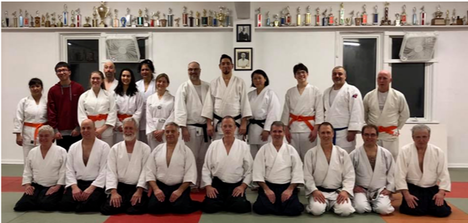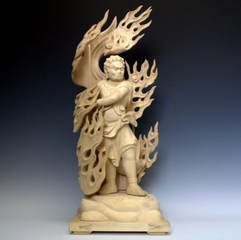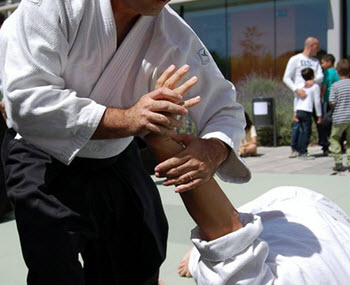
Mitori geiko refers to the concept of practicing by watching. Typically, we practice mitori geiko when we are unable to practice due to an unfortunate injury (often sustained outside of training!) or when we arrive late for class. We learn by watching the instructor and analyzing his/her movement. However, there are also other ways to practice mitori geiko. In fact, technology provides us with more opportunities to practice mitori geiko than was likely true for students in the past. Before the advent of modern technologies, watching, analyzing and attempting to repeat an instructor’s movement was probably the only way to practice mitori geiko. All of that started to change with the publication of books with photographs, vhs, dvds, followed by Youtube, Facebook and Instagram. We are now able to watch, analyze, rewind, and watch again.
Although useful, I think we should keep in mind that there are limits to this type of training. Sometimes these limits are purely technical in nature; for instance, the quality of the medium and resolution of the image can make it difficult to make out what is actually happening. Another, more important, limit on mitori geiko has more to do with the individual student and his/her ability to understand what he/she is actually seeing. It’s as if we have “filters” that limit our ability to see what is literally happening in front of our eyes. I have often noted during my own mitori geiko how different students on the mats appear to be doing the technique in a different manner despite having received the same instruction and seen the same movements—at the same time!
One of our “filters” probably derives from the depth of our technical foundation and knowledge of the riai of the techniques. It is easier to appreciate what one is seeing and “steal” technique when one has a solid technical foundation and a basic understanding of the techniques being demonstrated. We also need to know where to look—focusing on the upper body and arm/hand movements is often not as effective as focusing on foot, knee and hip movements. However, even when one accounts for differences in technical foundation and in where one chooses to focus one’s attention, differences in how students perceive the technique still emerge. I wonder if this not related, in part, to differences in the degree of openness and lack of preconceptions between students. In other words, perhaps the effectiveness of our practice of mitori geiko increases to the extent that we are able to adopt an attitude of openness and lack of preconceptions toward what we are seeing (shoshin).
Years ago, when I was practicing Karate, my instructor mentioned to me that it is much easier to see what someone does wrong than to see what they do well. Mitori geiko is an important part of our practice; however, it is no substitute for actually spending time on the mats training with a qualified instructor. Ultimately, I think that what we “see” is filtered through our mind; however, what we feel when practicing on the mats with more advanced aikidoka is not so easily put in words or mental categories and is, perhaps, closer to the truth of what we are trying to learn.
Contributed by:
Hans DeGroot,
Aikido Yoshinkai Ottawa
Although useful, I think we should keep in mind that there are limits to this type of training. Sometimes these limits are purely technical in nature; for instance, the quality of the medium and resolution of the image can make it difficult to make out what is actually happening. Another, more important, limit on mitori geiko has more to do with the individual student and his/her ability to understand what he/she is actually seeing. It’s as if we have “filters” that limit our ability to see what is literally happening in front of our eyes. I have often noted during my own mitori geiko how different students on the mats appear to be doing the technique in a different manner despite having received the same instruction and seen the same movements—at the same time!
One of our “filters” probably derives from the depth of our technical foundation and knowledge of the riai of the techniques. It is easier to appreciate what one is seeing and “steal” technique when one has a solid technical foundation and a basic understanding of the techniques being demonstrated. We also need to know where to look—focusing on the upper body and arm/hand movements is often not as effective as focusing on foot, knee and hip movements. However, even when one accounts for differences in technical foundation and in where one chooses to focus one’s attention, differences in how students perceive the technique still emerge. I wonder if this not related, in part, to differences in the degree of openness and lack of preconceptions between students. In other words, perhaps the effectiveness of our practice of mitori geiko increases to the extent that we are able to adopt an attitude of openness and lack of preconceptions toward what we are seeing (shoshin).
Years ago, when I was practicing Karate, my instructor mentioned to me that it is much easier to see what someone does wrong than to see what they do well. Mitori geiko is an important part of our practice; however, it is no substitute for actually spending time on the mats training with a qualified instructor. Ultimately, I think that what we “see” is filtered through our mind; however, what we feel when practicing on the mats with more advanced aikidoka is not so easily put in words or mental categories and is, perhaps, closer to the truth of what we are trying to learn.
Contributed by:
Hans DeGroot,
Aikido Yoshinkai Ottawa






 RSS Feed
RSS Feed